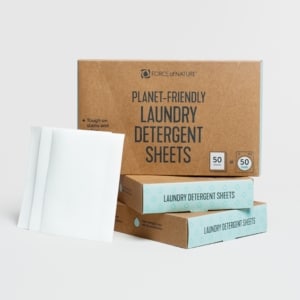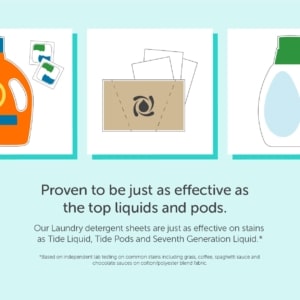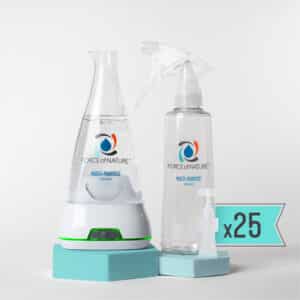The pandemic has driven an unprecedented prioritization of health and well-being in the workplace. The standards for keeping your clients, customers and employees safe and healthy have never been higher. With public health researchers concerned about the dangerous health impact from the chemicals being used to fight Covid-19, people have begun to realize that all those chemicals that are supposed to keep us safe are actually introducing us to other hazards. Chronic exposure to the 3 most common disinfectant chemicals – bleach, quaternary ammonium compounds (quats), and fragrances – come at a huge cost to the health and well-being of employees and customers. One large segment of people who have extra cause for concern are people who suffer from asthma and allergies, which is 30% of US adults. In fact, the CDC recommends not using cleaning products with quats, bleach, or fragrances around this population. Many business owners don’t know that conditions like asthma and allergies are included under the ADA, and that an easy step you can take is to replace cleaning products with specific toxic ingredients.
In both the ADA and Section 504, a person with a disability is someone who has a physical or mental impairment that seriously limits one or more major life activities or who is regarded as having such impairments. Allergies and asthma are typically considered disabilities under this definition, as they impact a person’s ability to breathe, eat, work, and go to school. No one regulates cleaning products to ensure they comply with any specific health guidelines for people with asthma and allergies. To protect your clients and employees who suffer from allergies and asthma, and comply with guidelines set forth by the ADA and other leading experts), the most critical step is to swap out any cleaning products containing bleach, quats or fragrances.
Here’s how Force of Nature can help your business protect your clients, customers and staff – and comply with important ADA guidelines.
ADA, Asthma, and Allergies: How To Protect Your Staff And Clients
Did you know that a condition doesn’t have to be present every day in order to be included in ADA guidelines? Allergies and asthma are often exacerbated by triggers, showing increased symptoms at certain times, and are included under the ADA’s considerations required for a safe, healthy environment for people who suffer from these conditions. These guidelines help ensure that employers maintain an environment where their staff and clients can gain relief from interventions necessary to their health and safety.
Top 3 Things To Know About Your Business Cleaning and Disinfecting Products, Allergy & Asthma
1.They Almost Certainly Contain Toxic Ingredients
The cleaning product category is not well regulated when it comes to health, and manufacturers don’t need to prove their ingredients are safe for people with asthma or allergies to come into contact with. Despite such a large proportion of the population suffering from these health challenges, it is practically impossible to avoid the 3 most problematic ingredients (with one exception that we’ll get to later). People with allergies and asthma are even more vulnerable to the harmful effects of cleaning products and disinfectant ingredients.
2. They Pose SERIOUS Risk To Those With Asthma and Allergies
Along with tobacco smoke, pets, dust mites, and mold, the CDC considers cleaning products to be asthma and allergy triggers. The health risks of cleaning products can be even more serious for children, where an estimated 37% of childhood asthma cases may be a result of exposure to chemicals in cleaning products. Bleach, quats, and fragrance ingredients are some of the worst offenders for inducing dangerous allergy and asthma flares, as these ingredients are particularly hard on the respiratory system. Unfortunately, these chemicals are so common that they’re almost impossible to avoid. In fact, they are part of a growing and important public health concern. Here’s what you need to know about bleach, quats, and fragrances:
- Bleach: While many people still believe bleach to be the gold standard in cleaning, we now know that the impact on people with asthma and allergies is one of many scary truths about bleach. Bleach (sodium hypochlorite) is a caustic substance that is a respiratory irritant and can cause serious burns to our delicate skin and eye tissue. The impacts of bleach also linger after the initial exposure. For example, some asthma sufferers continue to show reduced lung function the day after exposure to bleach.
- Quats are a class of compounds often used in cleaning products because of their antimicrobial properties. They come with serious health risks, including skin and respiratory irritation and exacerbating asthma and allergy symptoms. Quats linger on surfaces for a long time, so children and staff can be re-exposed to these chemicals even after the products have dried overnight.
- Fragrances: Fragrances often contain toxic chemicals that do not have to be disclosed by manufacturers due to a regulatory loophole (fragrances are considered “trade secrets”). As a result, hundreds of ingredients can be hidden under the term “fragrance” and almost every cleaning and disinfection product contains fragrances. In a research study among asthma sufferers, scented products triggered reactions so severe that 62.8% would be considered disabling under the ADA. Fragrances are considered hormone disruptors, neurotoxins, carcinogens, allergens, and asthma triggers – a concern for children because this exposure compounds over time.
3. The Risk Is Exponential
The health risks of conventional disinfectants accumulate over time. For example, chronic exposure to cleaning products (particularly those that contain bleach, quaternary ammonium compounds and fragrances) is so dangerous that research has proven it can be as harmful to our lungs as smoking a pack of cigarettes a day. Another major study showed a 35% increase in the risk of COPD in people who used disinfectants weekly and a 45% increase for those using them more often.
Even if children aren’t present in your business, toxic chemical exposure to their parents has an impact on them. Mothers who are chronically exposed to cleaning products have been proven to be up to 70% more likely to have children with asthma. Because of their smaller size, children are disproportionately at risk of harm from the toxic chemicals in conventional cleaning and disinfecting products – even those that are registered by the EPA. These health risks include an increased risk of asthma, allergies, and hormone disruption.
Make Protecting Your Staff and Clients Your Business with Force of Nature
We’re proud to tell you that you don’t have to choose between effective cleaning and keeping your staff and clients safe, even people with asthma and allergies. We launched our Force of Nature appliances to end the compromise between what works and what’s gentle to people and our planet. Our appliances use electricity to convert tap water, plus a tiny capsule of salt, water and vinegar, into an all-in-1 cleaning, deodorizing, sanitizing, and disinfecting formula that meets the EPA’s stringent germ-kill requirements, and performs as well or better in 3rd party independent testing as the leading brands. Our formula is a hospital-grade EPA registered disinfectant that kills 99.9% of germs including Staph, MRSA, Salmonella, Listeria, Pseudomonas, Norovirus, and Influenza A and is on the EPA’s List N, the disinfectants approved for use against SARS-CoV-2, the cause of Covid-19. And good news – “EPA expects all products on List N to kill all strains and variants of SARS-CoV-2”.
Force of Nature Contains No Harmful Chemicals, Asthma or Allergy Triggers
Our formula earns the highest possible rating from Mayo Clinic’s SkinSafe Allergy Rating System. It’s free from skin and respiratory irritants and is so gentle it can even be used without rinsing or protective gear like gloves or masks. The antimicrobial ingredient in our product, hypochlorous acid, is so gentle that it has several uses in the industrial space. It’s used by surgeons on wounds, ophthalmologists to treat infections in the eyes, and dermatologists to prevent skin infections. Unlike conventional cleaners, our formula contains no bleach, quats, alcohol, fragrances, dyes, preservatives or surfactants.
One Technology, 2 Sizes. Meet Force of Nature Pro!
We have 2 size options to meet the needs of both smaller and larger organizations: our 12 ounce Force of Nature for smaller workplaces and homes, and our new large-capacity, commercial-grade Force of Nature Pro that makes 32 or 64 ounces. Both appliances use an electronic control system that senses and automatically adapts to accommodate differences in water chemistry and temperature to ensure that every batch made meets the EPA’s strict germ-kill standards.
We’re proud to offer organizations and businesses a product that meets unmatched standards when it comes to protecting people with asthma and allergies. With our powerful yet gentle formula, you can take comfort that you are effectively disinfecting and cleaning your facility without putting your employees, customers, or clients at risk from conventional cleaning chemicals. Purchasing for a large business or organization? We can customize pricing, assortment and training for you! Just click here to get started.




